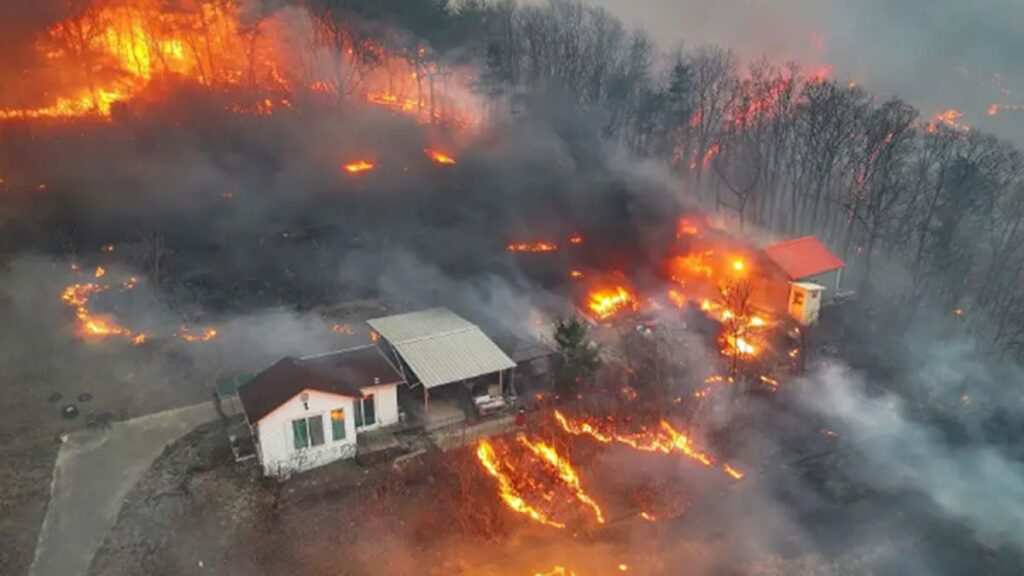At least 24 people have lost their lives as several wildfires persist in devastating South Korea’s southeast region.
The fires began in Sancheong county on Friday afternoon and quickly spread to Uiseong county, according to authorities. Strong, dry winds have fueled the flames, causing them to advance into nearby counties, including Andong, Cheongsong, Yeongyang, and Yeongdeok, as reported by Yonhap news agency.
The majority of the victims, according to authorities, are in their 60s and 70s. They also reported that about 26 individuals were hurt, with 12 in critical condition.
A pilot who unfortunately died in a helicopter crash while attempting to suppress the wildfires in Uiseong, one of the most affected places, is among the dead. There were no other crew members in the chopper.
South Korea: The wildfire was like an ‘apocalypse’

Wildfires are relatively rare in South Korea, and the current fires have already become the deadliest in the country’s history.
The wildfires destroyed around 17,000 hectares (42,000 acres) of forest, making it one of the largest wildfires in terms of area in South Korea’s history. A 30-year-old man from Uiseong shared his heartbreak: “Both the upstairs and next-door houses were burned down. This area is full of grandparents. They have lived here their whole lives, and when their houses burn down, they have nowhere to go.”
The fire destroyed the Gounsa temple in Uiseong, one of the largest temples in the province, originally built in 618 AD. A 68-year-old monk expressed his sorrow, saying he felt “devastated” upon hearing about the temple’s destruction. “We will do our best to restore the function of the temple,” he told AFP.
Forestry authorities confirmed that a Buddhist architectural structure from the Joseon Dynasty (1392-1910), considered a national treasure, was destroyed.
Crews struggling to control the fire
In a televised address, South Korea’s acting President Han Duck-soo described the wildfires as the worst the country has faced, warning of escalating damage. “Damages are snowballing,” Han said, emphasizing the urgency of focusing all efforts to extinguish the fires.
Overnight, crews struggled to contain the fires due to strong winds; some 4,650 firefighters, troops, and other personnel, assisted by 130 aircraft, worked to combat the flames.
The forecast predicted a little rain on Thursday, but it remained unclear whether it would be helpful. At least four wildfires, including one close to Yeongdeok, were blazing as of Wednesday night, prompting evacuations.
Andong authorities forced two communities, including the UNESCO World Heritage Site of Hahoe traditional hamlet, to evacuate. They also advised hikers to evacuate as another fire approached Jirisan Mountain. Despite early reports of containment, wind and dry weather caused the fires to spread again.
The Korea Forest Service has issued the highest degree of wildfire warning nationwide. As a result, local governments must urge military units to delay live-fire drills, tighten park and forest entry restrictions, and deploy more emergency personnel.


 Underreported Climate Migration Surges in South Asia
Underreported Climate Migration Surges in South Asia  Kathmandu valley sees improvement in air quality
Kathmandu valley sees improvement in air quality  India terminates cargo shipment to Bangladesh
India terminates cargo shipment to Bangladesh  South Korea to hold presidential election on June 3
South Korea to hold presidential election on June 3  The U.S. threatens to apply 50% tariffs to China
The U.S. threatens to apply 50% tariffs to China  Why is Brazil Cutting Amazon Forest?
Why is Brazil Cutting Amazon Forest?